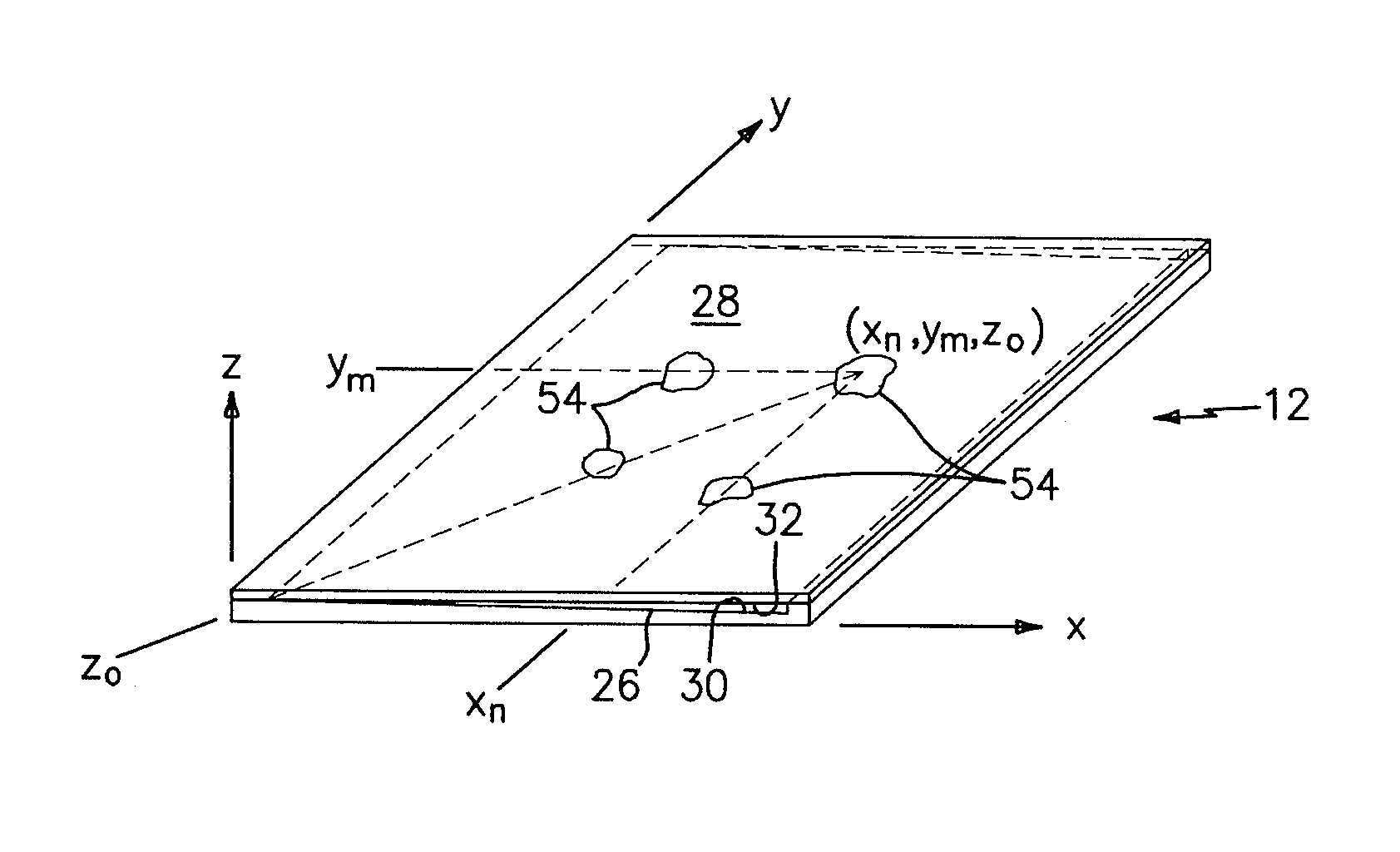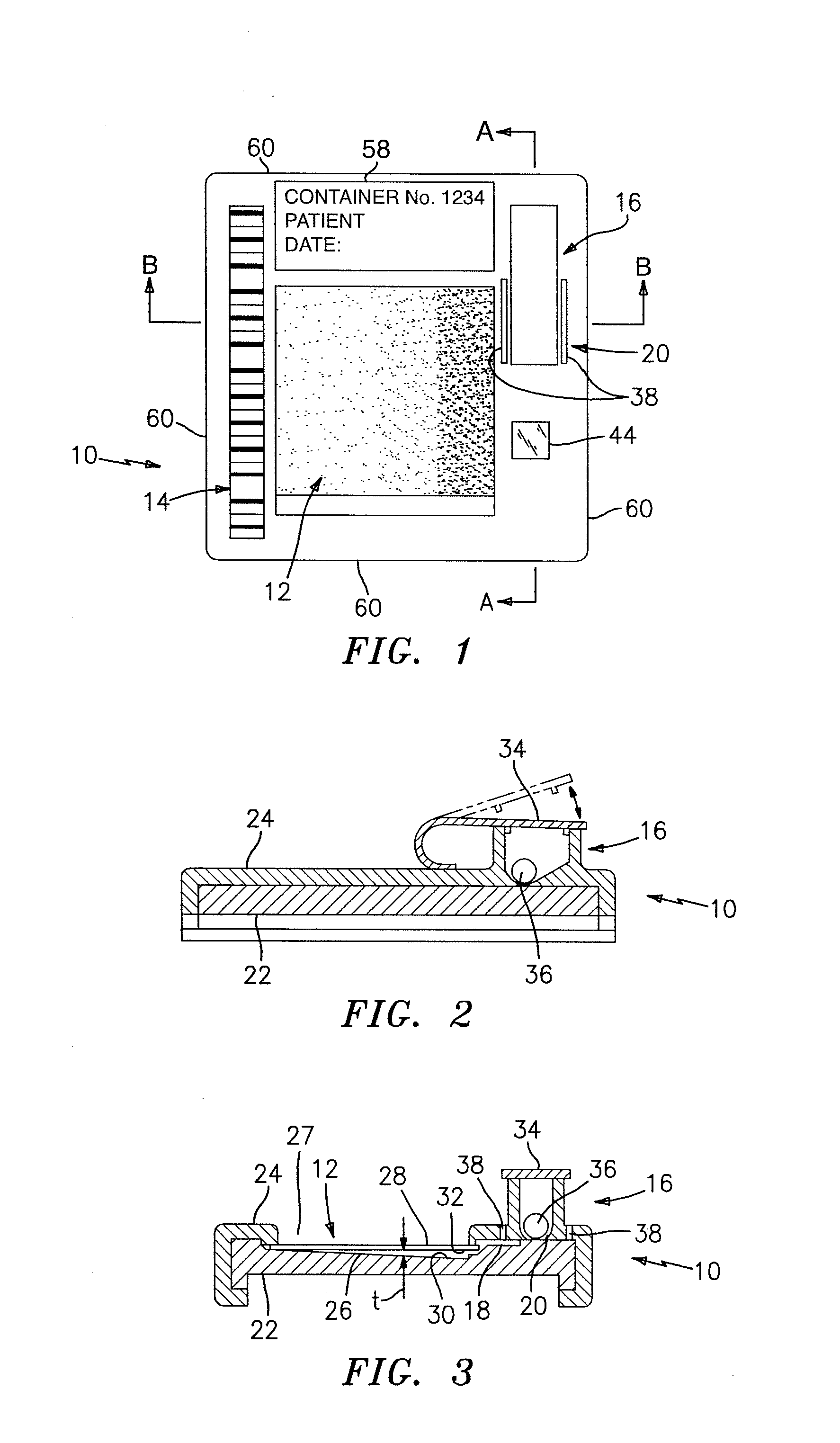Container for holding biologic fluid for analysis
a technology for biologic fluid and container, which is applied in the field of containers for holding biologic fluid samples, can solve the problems of increasing the complexity of the machine, undesired cost of the cuvette, and wide dynamic range of particles that must be enumerated, so as to reduce the amount of equipment required to do the same number of analyses, the effect of reducing the number of tests and great utility
- Summary
- Abstract
- Description
- Claims
- Application Information
AI Technical Summary
Benefits of technology
Problems solved by technology
Method used
Image
Examples
example i
Hematological Analyses
[0053]Referring to FIGS. 1 and 4, to enable an analysis of white blood cells (WBC's) within an anticoagulated whole blood sample, the container 10 includes approximately 0.8 micrograms (μg) of a sensible colorant disposed within the reservoir 16. EDTA is an example of an anticoagulating agent that may be used with the sample and a fluorescent highlighting supravital stain such as acridine orange, basic orange-21, or the like are examples of sensible colorants that may be added to the reservoir 16. For purposes of evaluating WBC's, it is preferable to have a region within the chamber 12 that has a plurality of select fields with a through-plane thickness on the order of 20 microns in magnitude. A chamber 12 through-plane thickness (i.e., a type of physical characteristic) of approximately 20 microns is chosen for a couple of reasons. First, an evaluation volume of 0.02 μl, (formed by a particular field of the chamber 12 having a cross-sectional area of 1 millime...
example ii
Chemical Analyses
[0057]Referring to FIG. 9, a complete blood count requires that the RBC's be evaluated for hemoglobin content. In a first embodiment, the hemoglobin evaluation is performed in a first chamber 62 which is connected to the reservoir 16 by a channel 18. At least two chemical reagents 64,66 are initially stored within the first chamber 62. The reagents 64,66 are shown in the first chamber 62 as independent deposits to illustrate the use of multiple reagents. Reagents can often be combined into a single reagent mixture stored as a single deposit. One of the chemical reagents 64 is a lysing reagent which breaks down RBC's within the sample and thereby releases the hemoglobin stored within the RBC's. The other reagent 66 is a hemoglobin stabilizer that increases the reliability of the hemoglobin evaluation. In most cases, the hemoglobin evaluation is performed after the lysing agent has been introduced into the sample for a given period of time, or at particular intervals....
example iii
[0059]Referring to FIG. 5, a complete urinalysis requires a chemical analysis and a particulate analysis of the urine sample. Chemical reagents 70 spatially located at particular coordinate addresses within a chamber are used to colorometrically relate information after a given period of time. The particulate analysis involves detecting, evaluating and / or enumerating the particles within the sample. In a first embodiment, the chemical analysis is performed in a first chamber 72 and the particulate analysis is performed in a separate second chamber 74. Both the first chamber 72 and the second chamber 74 are in fluid communication with the reservoir 16. In a manner similar to that described above, the through-plane thickness and other physical characteristics of the first chamber 72 and the second chamber 74 are chosen to facilitate the chemical and particulate analyses, respectively. In the first embodiment, the features operable to enable the analysis of the biologic fluid...
PUM
| Property | Measurement | Unit |
|---|---|---|
| thickness | aaaaa | aaaaa |
| thickness | aaaaa | aaaaa |
| through-plane thickness | aaaaa | aaaaa |
Abstract
Description
Claims
Application Information
 Login to View More
Login to View More - R&D
- Intellectual Property
- Life Sciences
- Materials
- Tech Scout
- Unparalleled Data Quality
- Higher Quality Content
- 60% Fewer Hallucinations
Browse by: Latest US Patents, China's latest patents, Technical Efficacy Thesaurus, Application Domain, Technology Topic, Popular Technical Reports.
© 2025 PatSnap. All rights reserved.Legal|Privacy policy|Modern Slavery Act Transparency Statement|Sitemap|About US| Contact US: help@patsnap.com



